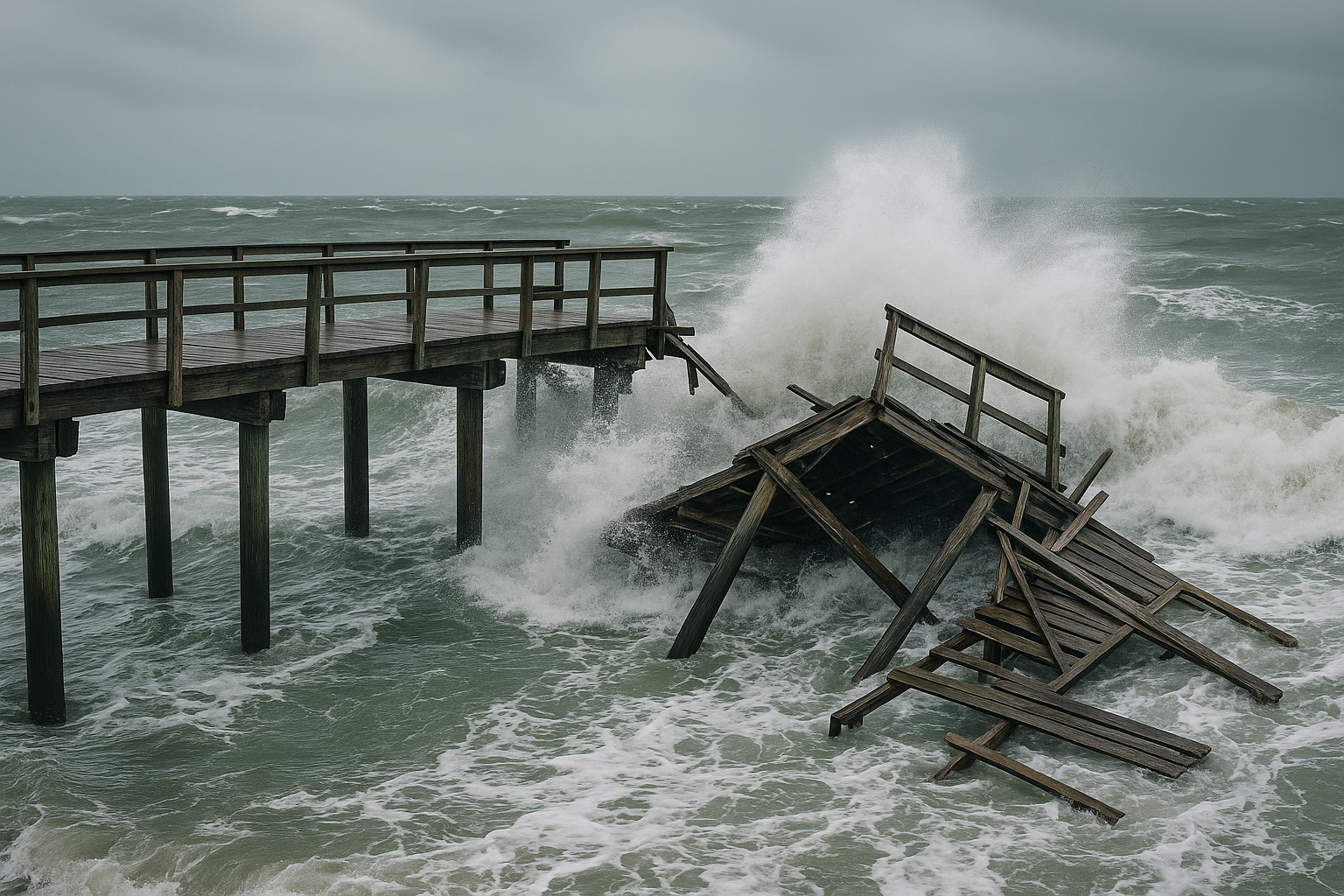As the seasons change and spring arrives, many coastal communities face a familiar yet daunting challenge: springtime flooding. The combination of rising sea levels, increased wave action, and heavy rainfall can put immense pressure on shoreline defenses. For those living in waterfront properties, understanding and implementing effective coastal protection measures is essential.
Among the various structures designed to mitigate these risks, bulkheads play a significant role in safeguarding against the forces of water and soil erosion. In this article, we will delve into the world of bulkheads, exploring their design, functionality, and the vital role they play in coastal defense, helping you to better prepare your property against the threats of springtime flooding.
Understanding Bulkheads and Their Design
What Are Bulkheads?
Bulkheads are specialized structures designed to serve as a barrier between land and water, particularly in coastal and waterfront areas. Unlike seawalls, which are often larger and intended to resist significant coastal erosion, bulkheads are generally smaller and focused on retaining fill in areas with limited to moderate wave action.
They are commonly used in marina basins, protected shorelines, and along filled areas where a clear separation between land and sea is necessary.
Key Features of Effective Bulkheads
Effective bulkheads are characterized by several key features that ensure their durability and functionality. First, they can be constructed from a variety of materials, including concrete, stone, steel, and timber.
These materials can be used to build piled and anchored walls or gravity walls, depending on the specific needs of the site. For instance, concrete and stone walls can be constructed as gravity walls, while steel and timber walls are often piled and anchored.
Bulkheads also often incorporate specialized designs, such as mesh boxes filled with stones (known as Gabion type), which provide additional stability and erosion resistance. The stability of bulkheads is derived from the mobilization of passive earth pressures and, in many cases, from a lateral restraint system installed between the mean low water level and the top of the wall.
Another key aspect of bulkhead design is their ability to withstand environmental factors. They must be engineered to resist erosion caused by mild to moderate wave climates and to maintain elevated grades along shorelines.
This involves careful consideration of the local wave action, soil conditions, and the overall structural integrity of the bulkhead to ensure it can withstand the forces imposed by water and soil .
The Role of Bulkheads in Coastal Defense
Protection from Erosion and Property Loss
Bulkheads play a critical role in protecting coastal properties from the detrimental effects of erosion and water damage. By acting as a barrier between the land and the sea, bulkheads prevent the sliding or washing away of land, especially in areas with filled or reclaimed soil. This is particularly important in marina basins and along protected shorelines where the risk of erosion is heightened due to mild to moderate wave action.
In addition to retaining fill and preventing land slippage, bulkheads also safeguard homes and businesses from water damage. By stabilizing the shoreline, they ensure that the integrity of the land is maintained, thereby protecting the investments and livelihoods of property owners.
The use of durable materials such as concrete, steel, and treated wood in bulkhead construction further enhances their ability to withstand the forces of water and soil erosion.
Contribution to Flood Control
Bulkheads also contribute significantly to flood control measures in coastal areas. While they may not offer the same level of wave protection as seawalls, their ability to retain land and stabilize the shoreline helps in mitigating the impact of flooding.
During periods of high tides or heavy rainfall, bulkheads help to prevent water from encroaching onto land, thereby reducing the risk of flooding and associated damage to properties.
Moreover, bulkheads can be integrated into broader flood control strategies that include other coastal protection structures such as seawalls and revetments. By forming part of a comprehensive shoreline defense system, bulkheads help to ensure that the overall integrity of the coastline is maintained, providing a layered defense against the various threats posed by water and weather conditions .
Case Studies: Success Stories of Bulkheads in Action
Coastal Community A – Before and After Bulkhead Installation
To illustrate the effectiveness of bulkheads in coastal defense, let’s consider the example of the Edenhouse boat ramp on the Chowan River in North Carolina. Prior to the installation of a new shoreline protection system, the area was plagued by severe erosion due to high wave energy and the failure of an existing 400-linear-foot bulkhead.
The erosion not only threatened the structural integrity of the boat ramp but also posed significant environmental concerns.
After consulting with the North Carolina Coastal Federation, the decision was made to replace the failing bulkhead with a living shoreline. However, for many coastal communities, traditional bulkheads remain a viable and effective solution.
For instance, in areas where living shorelines are not feasible, well-constructed bulkheads can significantly reduce erosion and protect properties. In such cases, the installation of a bulkhead involves careful planning and execution to ensure that the structure can withstand local wave and tidal conditions.
In the context of traditional bulkheads, the Galveston Seawall in Texas serves as a prime example. Built after the devastating 1900 hurricane, this 10-mile long structure has successfully protected the city of Galveston from numerous storms and hurricanes. While the Galveston Seawall is a seawall rather than a bulkhead, it highlights the effectiveness of similar coastal protection measures in safeguarding communities against the forces of nature.
Impact Assessment – Measuring Success in Coastal Protection
Assessing the success of bulkheads in coastal protection involves several key metrics. One critical aspect is the reduction in erosion and property loss.
Effective bulkheads should minimize the impact of wave action and prevent soil erosion, thereby stabilizing the shoreline and protecting adjacent properties. For example, the living shoreline project at Edenhouse, although not a traditional bulkhead, demonstrated significant success in stabilizing the shoreline and promoting ecological restoration, despite initial challenges posed by high wave energy.
Another important metric is the environmental impact. While bulkheads can sometimes increase erosion in front of the structure and starve downdrift beaches of sediment, well-designed and strategically placed bulkheads can mitigate these effects.
It is essential to monitor changes in sediment inputs and their impact on local habitats to ensure that the bulkhead does not inadvertently harm the environment. Studies have shown that bulkheads can have negative effects on beach ecosystems, but careful planning and design can minimize these impacts.
Finally, the long-term durability and maintenance requirements of the bulkhead are key indicators of its success. Bulkheads made from durable materials such as concrete, steel, or treated wood can withstand environmental factors and require less maintenance over time.
The Galveston Seawall, for instance, has undergone several modifications and improvements, showcasing the importance of ongoing maintenance and adaptation to ensure the longevity of these protective structures .
Conclusion
No matter the scope or stage of your waterfront project—whether you’re building new, making repairs, or preventing erosion—Gulf Coast Waterfront Solutions is your trusted partner along the Texas and Gulf Coast shorelines. Since 1996, we’ve delivered durable, attractive, and code-compliant marine construction with zero upfront payment and a commitment to quality craftsmanship.
From bulkheads and floating docks to shoreline maintenance and permitting support, our team is ready to protect and enhance your property. Contact us today for a free estimate and discover why homeowners, developers, and businesses rely on GCWS to build smarter, stronger waterfronts that last.
FAQ
What are the primary causes of high-tide flooding, and how do they impact coastal communities?
The primary causes of high-tide flooding include sea level rise, changes in prevailing winds, shifts in ocean currents, and strong tidal forces, especially during full or new moon phases. These factors push water levels above the normal high tide mark, inundating streets, causing road closures, and overwhelming storm drains, significantly impacting coastal communities by increasing the frequency and severity of flooding .
How has the increase in sea levels affected the frequency and severity of high-tide flooding events in recent decades?
The increase in sea levels has significantly escalated the frequency and severity of high-tide flooding events. Since 2000, the annual frequency of high-tide flooding in the U.S. has more than doubled, and it is projected to more than triple again by 2050. Flooding now occurs more often, even on days with less extreme tides, and is expected to increase in depth and extent .
What are the different types of coastal flooding, and how do they relate to high-tide events?
Coastal flooding occurs through three main types:
- Direct flooding : Seawater exceeds land elevation, often where natural barriers are absent.
- Overtopping of a barrier : Waves exceed the height of natural or engineered barriers, flooding the land behind.
- Breaching of a barrier : Barriers are broken by waves, allowing seawater to flood inland. These types can be exacerbated by high-tide events, especially when combined with storm surges, which increase the water level and the likelihood of overtopping or breaching .
How can bulkheads and other coastal defense structures mitigate the effects of high-tide flooding and other coastal geohazards?
Bulkheads can mitigate the effects of high-tide flooding and other coastal geohazards by retaining fill and preventing land erosion in sheltered coastal environments. However, they are less effective against powerful wave action compared to seawalls. Seawalls, on the other hand, offer superior defense against severe coastal erosion and powerful waves, protecting shoreline integrity and maintaining consistent water depths, especially in marina settings .

